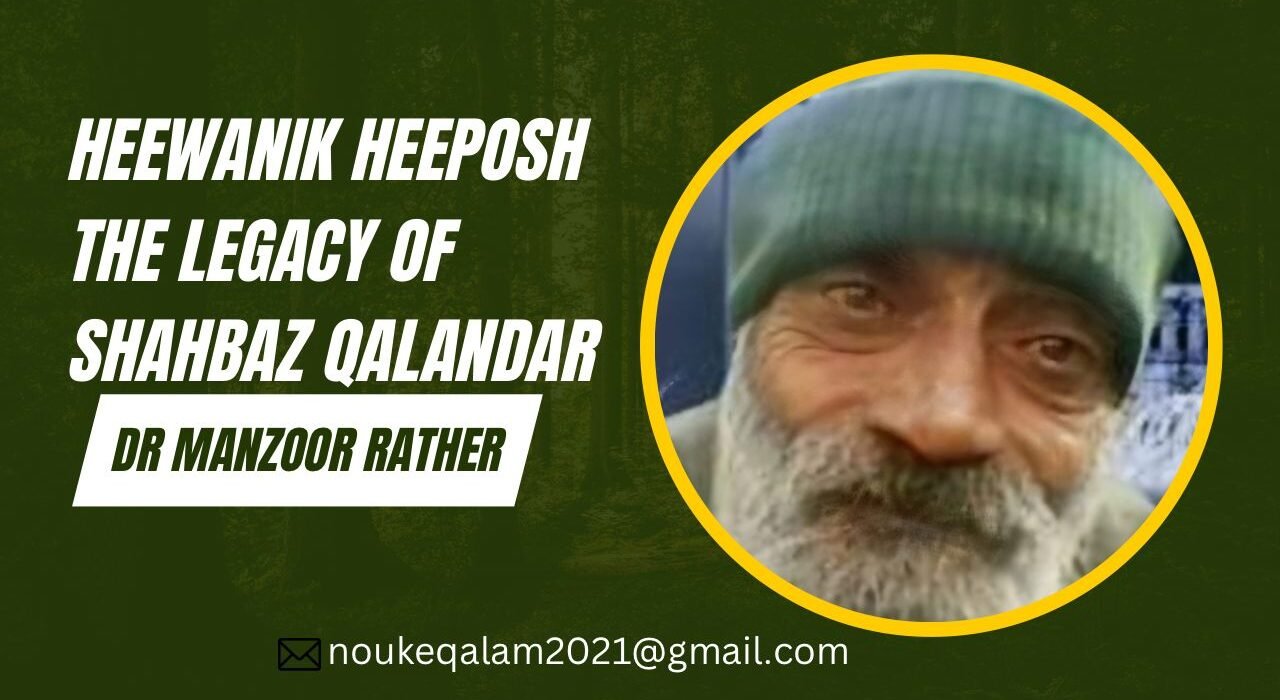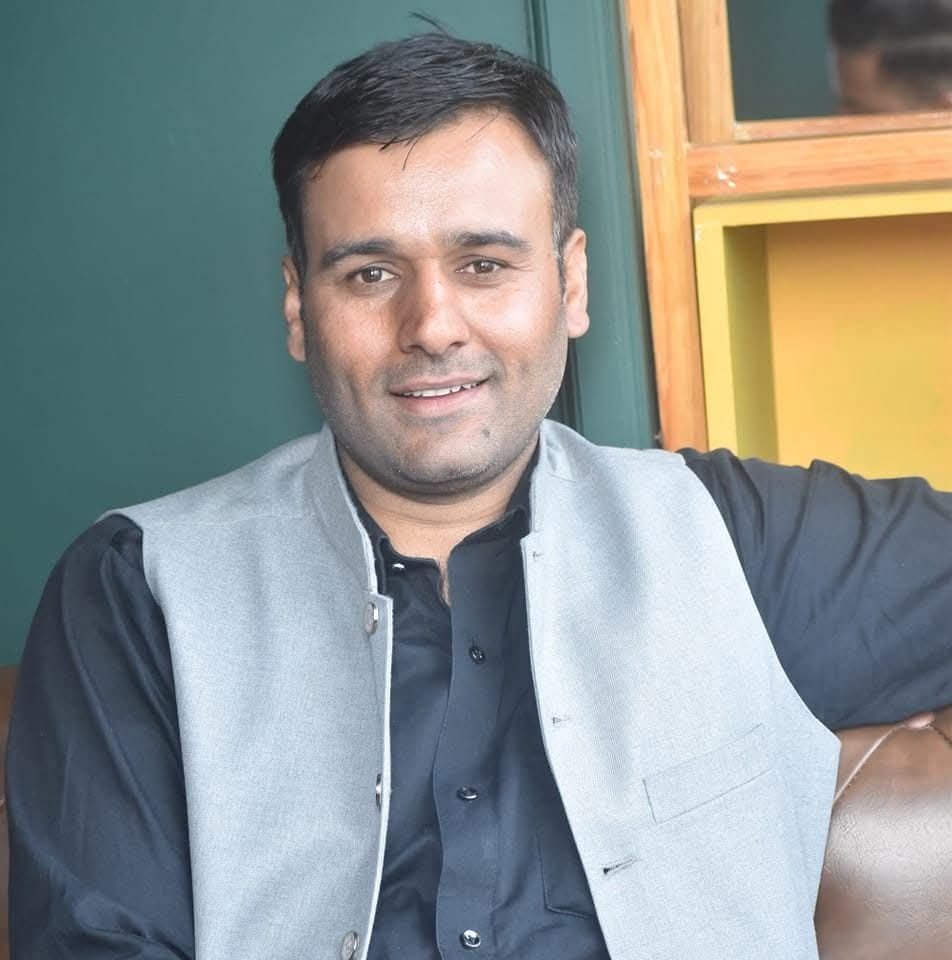
Original Script of Shahbaz Qalanders Handwritten notes of the Book which dates back 1971
Jasmine, known as ~Heeposh~ in Kashmiri, is one of the most fragrant flowers that bloom in Kashmir during late summers. The title of the book “Heewanik Heeposh” was metaphorically chosen by the editors of the poetry collection, emphasizing its cultural and poetic essence. The book, divided into two sections, features a total of thirty poems—nineteen composed by Qalandar Shahbaz and eleven by his father, Abdul Rehman Sofi.
Qalandar Shahbaz: The Mystic Poet of Heewan.
Muhammad Shahbaz Sofi, popularly known as Qalandar Shahbaz, was a mystic Sufi poet born and raised in Heewan village in Narvaw valley of Baramulla District. He is more known in the social circles than in the literary circles.
In his early years, he attended Primary School in Heewan but did not pursue formal education further. To sustain himself, he engaged in various professions, including baking and cooking. While there are no precise records of his birth, his grandson, Naseer Ahmad Sofi, estimates that he was born in 1943 and passed away on February 5, 2014. Although he was a baker and chef by profession, his spiritual and poetic contributions have left a lasting impact on Kashmiri literature and Sufi circles.
By 1967, he had fully embraced the life of a wandering Sufi, composing spontaneous verses. A widely circulated rumor claims that Qalandar Shahbaz burned all his writings in a bakery oven. However, a single handwritten copy, dating back to 1971, was preserved by his brother, Muhammad Yousuf Sofi, and later compiled into the book Heewanik Heeposh. His grandson, however, refutes this claim, asserting that some of his works were preserved and subsequently compiled into Heewanik Heeposh, which was published posthumously on February 5, 2016.
Dr Manzoor Ahmad Rather had the privilege of accessing the original handwritten notebook, which was safeguarded by the poet’s family.

Abdul Rahman Sofi, the father of Shahbaz Qalandar, was a tailor, baker, and chef by profession but was deeply devoted to Sufism. He followed the Chishti Silsila and was a disciple of Ahmad Parray of Nawab Bazar, Srinagar.Though there is no official record of Abdul Rehman Sofi’s birth, he passed away on 5th April 1962. His poetry, which carried themes of divine love and mysticism, was later compiled into Heewanik Heeposh alongside his son’s writings.
The Sufi Path of Qalandar Shahbaz
The Qalandars emerged as a distinct Sufi movement across the globe characterized by their unique lifestyle, attire, and spiritual practices. They include notable figures like Shaykh Jamaluddin, Hassan al-Jawaliqi of Iran, Bu Ali Shah Qalandar of Panipat, and Lal Shahbaz Qalandar of Sindh. Unlike organized Sufi orders, Qalandars and Malamati mystics led wandering lives, prioritizing divine love over social conventions.
Qalandar Shahbaz followed the Chishti Silsila (Sufi order) under the guidance of his father, Abdul Rehman Sofi, a disciple of Ahmad Parray. Ahmad Parray, in turn, was a disciple of Waza Mehmood, tracing a spiritual lineage that led to Ahmad Sahab Machama. Shahbaz Qalandar’s transformation into a mystic was marked by a significant event at the time of his father’s passing. During his final moments, Abdul Rehman Sofi requested a glass of milk and instructed that it be given to his son. Upon drinking the milk, Shahbaz Qalandar reportedly lost interest in worldly affairs and embarked on a spiritual journey devoted to divine contemplation.Literary Contributions Although much of his work was lost, Heewanik Heeposh remains a testament to his poetic genius. The collection includes 30 poems, with 19 by Shahbaz Qalandar and 11 by his father, Abdul Rehman Sofi. His compositions include a long Nazrana Aqeedat (offering of Faith) in praise of Hazrat Baba Gafoor (RA) Peerniya Boniyar Baramulla.
Mystical Journey and Spiritual Life
In 1967, he began expressing his mystical experiences through poetry. His unconventional lifestyle led him to reside at Nowgul Paristan Nag, a spring on the outskirts of Heewan, where he often meditated under a grand Chinar tree. Later, he moved to Ijara Boniyar, where he stayed for about 12 years, frequently retreating to a cave in the nearby forest and visiting the shrine of Baba Gafoor (RA) in Peerniya.
After returning to Heewan, he continued his spiritual practice, often preparing tea for his disciples on a self-made choola (traditional clay stove). He gained widespread respect, attracting even non-Muslims who sought his blessings. One of the most intriguing incidents associated with him involved a press reporter, Muhammad Ameen Sheikh, who attempted to photograph him. Despite repeated efforts, the camera failed to function. It is said that after Qalandar gazed at him, Sheikh fell into a trance. His distressed parents sought the mystic’s help, and he reassured them that Sheikh would return— which he did, two months later.
Final Days and Legacy
Qalandar Shahbaz hosted an annual feast that drew people from all walks of life. His final days were marked by seclusion. On January 26, 2014, he revisited Ijara, stayed for five days, and returned to Heewan on January 31. Locking himself in his room for three days and nights, he finally emerged, instructing his disciples to prepare food before passing away on February 5, 2014, at 11:45 PM. His funeral witnessed an overwhelming turnout, and he was laid to rest in the local graveyard of his native village, Heewan.
The legacy of Qalandar Shahbaz lives on through his poetry, which continues to inspire spiritual seekers. His devotion, poetic expression, and mystical experiences place him among the revered Sufi figures of Kashmir. His verses, published in Heewanik Heeposh, serve as an enduring tribute to his mystical journey, literary contributions, and cultural significance in Kashmir.The annual Urs (death anniversary) of Shahbaz Qalandar is observed every year on the first Thursday of January at the Sheeri Narvaw residence of Manzoor Ahmad Lone, and on February 5 in both Ijara Boniyar and Heewan Narvaw, drawing devotees from across the Kashmir region.
About the Columnist
Dr. Manzoor Ahmad Rather, also known as Narvaw Walla, is a Kashmiri academic, researcher, and cultural activist from Baramulla. He founded the Narvaw Literary Society in 2020 and actively works to preserve Kashmiri literature, oral histories, and cultural heritage. His research focuses on Kashmiri folklore, women’s narratives, and the impact of Partition.
This Article is edited by Ikkz Iqbal






Altaf hussain dar Dar
February 5, 2025He was a really great sufi saint.